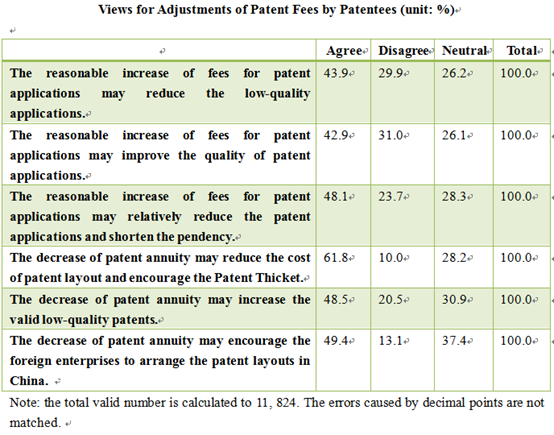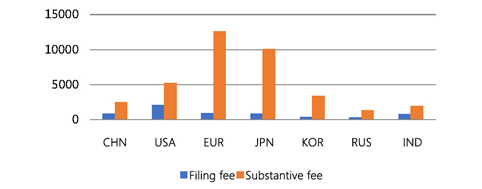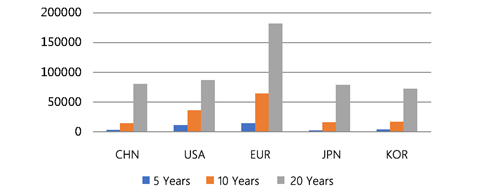Recently, the China Intellectual Property Administration (CNIPA) issued 2020 China Patent Report, in which a special topic wrote “the optimization of patent fees will benefit for improving the quality of patents”. Specifically, the patent fees are playing a vital role in filing patent applications, and working as an economic leverage to refine the patent system of China.
Earlier studies have shown that as a mechanism for selecting high-quality patents for invention, the increase of patent fees is beneficial to improve the quality of patents by reducing the low-quality applications.
(Note: the Department of Price of the National Development and Reform Commission had conducted a research on administrative fees at CNIPA prior to releasing the report.)
A patent application shall go through a complete and standard procedure covering filing, reviewing, granting and maintaining, in which some shall be paid fees. The patent fees, as an economic leverage, are positive for refining patent system. The reasonable fees in filing and granting an application will increase the high-quality patents to encourage innovation. According to the earlier studies, the European countries vary in the items, criterion, deadlines for charging patent fees, which is not good for the developments of innovation and economy. On the contrary, the patent fees in China are concise in structure, for not setting up search fee, RCE fee, licensing fee, extension of term of patent fee, etc., which are charged in the United States. China has also cancelled the registration fee and the printing fee, etc. Moreover, the patent fees are relatively lower in China.
The patentees in China at large agree that the patent fee schedule in China affects the patent quality and the patent layout, and shall be reasonably adjusted. Besides, the times for paying the annuity also shall be rescheduled.
1. The reasonable increase of the fees for filing patent applications is in favor for improving the quality of patents.
The patent fee schedule has been regarded as a tool for selecting the high-quality patents, and the low-quality applications can be reduced by increasing the patent fees. The studies have shown that 48.1% patentees support “the reasonable increase of fees for filing patent applications may relatively reduce the patent applications and shorten the pendency”, 24.4% higher than those who disagree. 43.9% patentees support “the reasonable increase of fees for filing patent applications may reduce the low-quality patent applications”, 14% higher than those who disagree. 42.9% patentees support “the reasonable increase of fees for filing patent applications may improve the quality of applications”, 11.9 higher than those who disagree.

Patent Fees of China are Lower than Other Countries or Regions
In regard to the filling fee (in RMB), China is comparable to European countries, Japan and India, but less than 1/2 of US. In regard to the substantive examination fee (in RMB), China is comparable to India, but much less than South Korea, only 1/2 of US, 1/4 of Japan, and 1/5 of EPO.

Filing Fees and Substantive Fees of Different Countries (unit: RMB)
In regard to the patent annuity (in RMB), China has maintained comparable to US, Japan and Korea over the past two decades, but less than 1/2 of European countries. But in Japan and Korea, the patent annuity shall be charged with additional fees if the claims are in excess of a specified quantity. In regard to the patent annuity a decade ago, China was 1/2 of US, and 1/4 of European countries.

Patent Annuity of Different Countries (unit: RMB)
In April of 2021, the Department of Price of the National Development and Reform Commission has conducted a research on administrative fees at CNIPA to figure out the procedures, service and fees of filing patent applications.
2. The reasonable patent annuity is in favor for promoting patent transformation and patent layout
The patent annuity usually rises with the maintenance period, which forces the patentees to exploit the patents to lower the costs, but also allows the patentees to abandon the patents to reduce the unnecessary expenses. According to the earlier survey, 61.8% patentees support “the lower patent annuity may reduce the cost of patent layout, and intensify the Patent Thicket”. 48.5% patentees support “the lower patent annuity may increase the number of valid low-quality patents”. 49.4% patentees support “the lower patent annuity may encourage the foreign enterprises to arrange their patent layouts in China”.
In recent years, USA has changed its patent fee schedule by adding the additional fee for the description, and increasing the additional fee for the claims. Moreover, the increase of patent annuity forces the applicants to carefully evaluate their patents in advance, to improve the patent transformations and reduce the low-quality patents for low-value invention. USA has also added the examination highway and the deferred examination with additional fees to meet different demands. In general, the trend of increasing the patent fees in USA is beneficial to improve the quality of domestic patents, but also to control the patent layouts from other countries, forming a kind of trade protection potentially. In view of such experience, the patent annuity in China is suggested to adjust to the conditions of patent layouts from the foreign applicants.
How to Charge Patent Annuity in Major Countries
In general, the patent annuities of different countries rise with the years of maintenance, but vary in specific times for payments. At present, the patent annuity of China has 6 grades, i.e., the rate of the annuity increases every three years and it is the same for the period from 16th till 20th validity years. It is calculated from the date on which a patent is granted. The patent annuities of Japan and South Korea are similar to ours. The patent annuities of Japan have 4 grades, i.e., the rate of the annuity increases every three years and it is the same from 10th validity year. The patent annuity of South Korea has 5 grades, i.e., the rate of the annuity increases every three years and it is the same from 13th validity year, and it is calculated from the date on which a patent is granted. The patent annuity of America shall be paid for three times, i.e., due at 3.5 years, 7.5 years and 11.5 years.